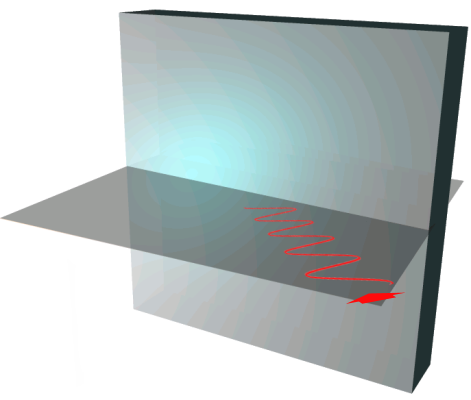Efficiency
wiki for efficiency calculations
Snell's law
A fraction of the light is reflected and another transmitted:
\(\theta_i =\) (normal) incidence angle
\(\theta_r =\) (normal) reflection angle (same as \(\theta_i\))
\(\theta_t =\) (normal) transmittance angle
\(N_1 =\) refraction index of material from which the ray is coming (left in image)
\(N_2 =\) refraction index of material into which the ray is going (right in image)
all parameters are potentially complex numbers. The refractive indices are retrieved from files (Palik, Henke, Cromer..)
Snell's law: \[ N_1 \sin \theta_i = N_2 \sin \theta_t \rightarrow \sin \theta_t = \frac{N_1}{N_2} \sin \theta_i \]
\(\theta_i\), \(N_1\), \(N_2\) are known, we are looking for \(\theta_t\).
We do not calculate the angle specifically but only the cosinus, which is sufficient for further calculations and more efficient/precise than calculating the angle itself because we do not need to use more trigonometric functions.
We can calculate the incidence angle \(\theta_i\) of each ray from its direction and the surface normal. Then we calculate \(\cos(\theta_i)\) and from that we can derive \(\cos(\theta_t)\) with snell's law:
\[ (\sin \theta_i)^2 = 1 - (\cos \theta_i)^2 \\ (\sin \theta_t)^2 = (\frac{N_1}{N_2})^2 (\sin \theta_i)^2 \\ \cos \theta_t = \sqrt{1 - (\sin \theta_t)^2} = \sqrt{1 - \Big(\frac{N_1}{N_2} \sin \theta_i\Big)^2} \]
The cosine of both angles is then used in the Fresnel equations to calculate the s- and p-polarization
Fresnel equation
Any polarization state can be described by two components: one vertical and one horizontal. Or - relative to the plane of incidence - s- and p-polarization. p-polarization (parallel, left image) lies parallel in the plane of incidence and s-polarization (senkrecht, right image) is orthogonal to the plane of incidence.


the reflectance of both polarizations is calculated with the fresnel equations:
\[r_s = \frac{N_1 \cdot \cos \theta_i - N_2 \cdot \cos \theta_t}{N_1 \cdot \cos \theta_i + N_2 \cdot \cos \theta_t}\] \[r_p = \frac{N_2 \cdot \cos \theta_i - N_1 \cdot \cos \theta_t}{N_2 \cdot \cos \theta_i + N_1 \cdot \cos \theta_t}\]
(The transmitted power is then "the rest": \(t_s = 1 - r_s\) and \(t_p = 1 -r_p\))